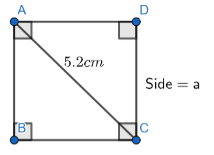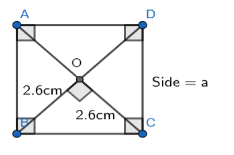
If the length of the diagonal of a square is 5.2 cm, then the area of the square is:
(A) \[15.12\,c{{m}^{2}}\]
(B) \[13.52\,c{{m}^{2}}\]
(C) \[12.62\,c{{m}^{2}}\]
(D) \[10\,c{{m}^{2}}\]
Answer
584.4k+ views
Hint: Assume that the side of the square is a cm. We know that in a square, all sides are equal and all the four angles of the square are right angles, that is \[90{}^\circ \] . Now, in \[\Delta ABC\] we have, AC = 5.2 cm, AB = BC= a and \[\angle B=90{}^\circ \] . Now, use the Pythagora's theorem in \[\Delta ABC\] and get the value of \[{{a}^{2}}\] . Put the value of \[{{a}^{2}}\] in the formula, \[\text{Area=}{{a}^{2}}\] and calculate the area of the square.
Complete step-by-step solution -
According to the question, we have a square and the length of the diagonal of the square is 5.2 cm.
The length of the diagonal of the square = 5.2 cm …………………………...(1)
Let us assume the side of the square is a cm.
We know the property of the square that the measure of every side of the square is equal to each other and all the four angles of the square are right angles that is \[90{}^\circ \] .

The length of the diagonal AC = 5.2 cm ……………………….(2)
Using the property, we can say that,
Side AB = CD = BC = AD = a ……………………………(3)
\[\angle A=\angle B=\angle C=\angle D=90{}^\circ \] ……………………….(4)
Now, in \[\Delta ABC\] , we have
AC = 5.2 cm {from equation (2)}
AB = BC= a {from equation (3)} ……………………..(5)
\[\angle B=90{}^\circ \]{from equation (4)} ………………………..(6)
So, we can say that \[\Delta ABC\] is a right-angled triangle.
We know that in a right-angled triangle, The pythagoras theorem can be applied. Since \[\Delta ABC\] is a right-angled triangle, so the Pythagoras theorem can be applied here.
Using Pythagoras theorem,
\[{{\left( Hypotenuse \right)}^{2}}={{\left( Base \right)}^{2}}+{{\left( Height \right)}^{2}}\]
\[{{\left( AC \right)}^{2}}={{\left( BC \right)}^{2}}+{{\left( AB \right)}^{2}}\] ………………………………..(6)
Now, putting the values of AC from equation (2), BC from equation (4) and AB from equation (5), in equation (6), we get
\[\begin{align}
& {{\left( 5.2 \right)}^{2}}={{\left( a \right)}^{2}}+{{\left( a \right)}^{2}} \\
& \Rightarrow \left( 5.2 \right)\left( 5.2 \right)=2{{a}^{2}} \\
& \Rightarrow \dfrac{\left( 5.2 \right)\left( 5.2 \right)}{2}={{a}^{2}} \\
\end{align}\]
\[\Rightarrow \left( 2.6 \right)\left( 5.2 \right)={{a}^{2}}\] ………………………..(7)
Now, we have to find the area of the square.
We know the formula, \[\text{Area=}{{a}^{2}}\] …………………….(8)
Putting the value of \[{{a}^{2}}\] from equation (7) in equation (8), we get
\[\text{Area=}\left( 2.6 \right)\left( 5.2 \right)c{{m}^{2}}=13.52c{{m}^{2}}\]
Therefore, the area of the square is \[13.52c{{m}^{2}}\] .
Hence, the option (B) is the correct one.
Note: We can also solve this question by using the property that the diagonals of a square bisect each other at right angles and the length of the diagonals are equal to each other. Using this property, we can say that the diagonal AC and BD are equal to each other and bisects at right angles at point O. So,
OC = OD = \[\dfrac{AC}{2}\] ………………………………(1)
\[\angle BOC=90{}^\circ \] ……………………………….(2)

Let us assume the side of the square is a cm.
We know that all sides of a square are equal. So,
AB = CD = BC = AD = a …………………….(3)
The length of the diagonal AC = 5.2 cm ………………….(4)
Now, from equation (1) and equation (4), we have
OC = OD = \[\dfrac{AC}{2}\] = \[\dfrac{5.2}{2}=2.6\] cm ………………………..(4)
In \[\Delta BOC\] , we have
\[\angle BOC=90{}^\circ \] {from equation (2)}
BC = a {from equation (3)}
OB = OC = 2.6 cm {from equation (4)}
We know that in a right-angled triangle, The pythagoras theorem can be applied. Since \[\Delta BOC\] is a right-angled triangle, so the Pythagoras theorem can be applied here.
Using Pythagoras theorem,
\[{{\left( Hypotenuse \right)}^{2}}={{\left( Base \right)}^{2}}+{{\left( Height \right)}^{2}}\]
\[{{\left( BC \right)}^{2}}={{\left( OB \right)}^{2}}+{{\left( OC \right)}^{2}}\] ……………………………………(5)
Now, putting the values of BC from equation (3), OB and OC from equation (4), in equation (5), we get
\[\begin{align}
& {{\left( a \right)}^{2}}={{\left( 2.6 \right)}^{2}}+{{\left( 2.6 \right)}^{2}} \\
& \Rightarrow {{a}^{2}}=2{{\left( 2.6 \right)}^{2}} \\
\end{align}\]
\[\Rightarrow {{a}^{2}}=13.52\] ………………………..(6)
We know the formula, \[\text{Area=}{{a}^{2}}\] …………………….(7)
Putting the value of \[{{a}^{2}}\] from equation (6) in equation (7), we get
\[\text{Area=}\left( 2.6 \right)\left( 5.2 \right)c{{m}^{2}}=13.52c{{m}^{2}}\]
Therefore, the area of the square is \[13.52c{{m}^{2}}\] .
Hence, the option (B) is the correct one.
Complete step-by-step solution -
According to the question, we have a square and the length of the diagonal of the square is 5.2 cm.
The length of the diagonal of the square = 5.2 cm …………………………...(1)
Let us assume the side of the square is a cm.
We know the property of the square that the measure of every side of the square is equal to each other and all the four angles of the square are right angles that is \[90{}^\circ \] .

The length of the diagonal AC = 5.2 cm ……………………….(2)
Using the property, we can say that,
Side AB = CD = BC = AD = a ……………………………(3)
\[\angle A=\angle B=\angle C=\angle D=90{}^\circ \] ……………………….(4)
Now, in \[\Delta ABC\] , we have
AC = 5.2 cm {from equation (2)}
AB = BC= a {from equation (3)} ……………………..(5)
\[\angle B=90{}^\circ \]{from equation (4)} ………………………..(6)
So, we can say that \[\Delta ABC\] is a right-angled triangle.
We know that in a right-angled triangle, The pythagoras theorem can be applied. Since \[\Delta ABC\] is a right-angled triangle, so the Pythagoras theorem can be applied here.
Using Pythagoras theorem,
\[{{\left( Hypotenuse \right)}^{2}}={{\left( Base \right)}^{2}}+{{\left( Height \right)}^{2}}\]
\[{{\left( AC \right)}^{2}}={{\left( BC \right)}^{2}}+{{\left( AB \right)}^{2}}\] ………………………………..(6)
Now, putting the values of AC from equation (2), BC from equation (4) and AB from equation (5), in equation (6), we get
\[\begin{align}
& {{\left( 5.2 \right)}^{2}}={{\left( a \right)}^{2}}+{{\left( a \right)}^{2}} \\
& \Rightarrow \left( 5.2 \right)\left( 5.2 \right)=2{{a}^{2}} \\
& \Rightarrow \dfrac{\left( 5.2 \right)\left( 5.2 \right)}{2}={{a}^{2}} \\
\end{align}\]
\[\Rightarrow \left( 2.6 \right)\left( 5.2 \right)={{a}^{2}}\] ………………………..(7)
Now, we have to find the area of the square.
We know the formula, \[\text{Area=}{{a}^{2}}\] …………………….(8)
Putting the value of \[{{a}^{2}}\] from equation (7) in equation (8), we get
\[\text{Area=}\left( 2.6 \right)\left( 5.2 \right)c{{m}^{2}}=13.52c{{m}^{2}}\]
Therefore, the area of the square is \[13.52c{{m}^{2}}\] .
Hence, the option (B) is the correct one.
Note: We can also solve this question by using the property that the diagonals of a square bisect each other at right angles and the length of the diagonals are equal to each other. Using this property, we can say that the diagonal AC and BD are equal to each other and bisects at right angles at point O. So,
OC = OD = \[\dfrac{AC}{2}\] ………………………………(1)
\[\angle BOC=90{}^\circ \] ……………………………….(2)

Let us assume the side of the square is a cm.
We know that all sides of a square are equal. So,
AB = CD = BC = AD = a …………………….(3)
The length of the diagonal AC = 5.2 cm ………………….(4)
Now, from equation (1) and equation (4), we have
OC = OD = \[\dfrac{AC}{2}\] = \[\dfrac{5.2}{2}=2.6\] cm ………………………..(4)
In \[\Delta BOC\] , we have
\[\angle BOC=90{}^\circ \] {from equation (2)}
BC = a {from equation (3)}
OB = OC = 2.6 cm {from equation (4)}
We know that in a right-angled triangle, The pythagoras theorem can be applied. Since \[\Delta BOC\] is a right-angled triangle, so the Pythagoras theorem can be applied here.
Using Pythagoras theorem,
\[{{\left( Hypotenuse \right)}^{2}}={{\left( Base \right)}^{2}}+{{\left( Height \right)}^{2}}\]
\[{{\left( BC \right)}^{2}}={{\left( OB \right)}^{2}}+{{\left( OC \right)}^{2}}\] ……………………………………(5)
Now, putting the values of BC from equation (3), OB and OC from equation (4), in equation (5), we get
\[\begin{align}
& {{\left( a \right)}^{2}}={{\left( 2.6 \right)}^{2}}+{{\left( 2.6 \right)}^{2}} \\
& \Rightarrow {{a}^{2}}=2{{\left( 2.6 \right)}^{2}} \\
\end{align}\]
\[\Rightarrow {{a}^{2}}=13.52\] ………………………..(6)
We know the formula, \[\text{Area=}{{a}^{2}}\] …………………….(7)
Putting the value of \[{{a}^{2}}\] from equation (6) in equation (7), we get
\[\text{Area=}\left( 2.6 \right)\left( 5.2 \right)c{{m}^{2}}=13.52c{{m}^{2}}\]
Therefore, the area of the square is \[13.52c{{m}^{2}}\] .
Hence, the option (B) is the correct one.
Recently Updated Pages
Master Class 8 Social Science: Engaging Questions & Answers for Success

Master Class 8 Maths: Engaging Questions & Answers for Success

Master Class 8 Science: Engaging Questions & Answers for Success

Class 8 Question and Answer - Your Ultimate Solutions Guide

Master Class 8 English: Engaging Questions & Answers for Success

Why are manures considered better than fertilizers class 11 biology CBSE

Trending doubts
What is BLO What is the full form of BLO class 8 social science CBSE

Citizens of India can vote at the age of A 18 years class 8 social science CBSE

Full form of STD, ISD and PCO

Right to vote is a AFundamental Right BFundamental class 8 social science CBSE

What is the difference between rai and mustard see class 8 biology CBSE

Summary of the poem Where the Mind is Without Fear class 8 english CBSE




